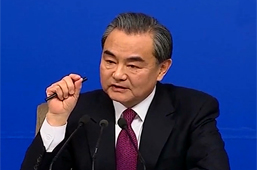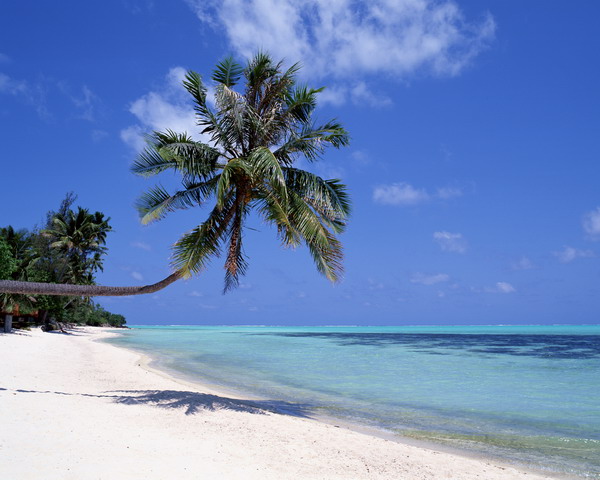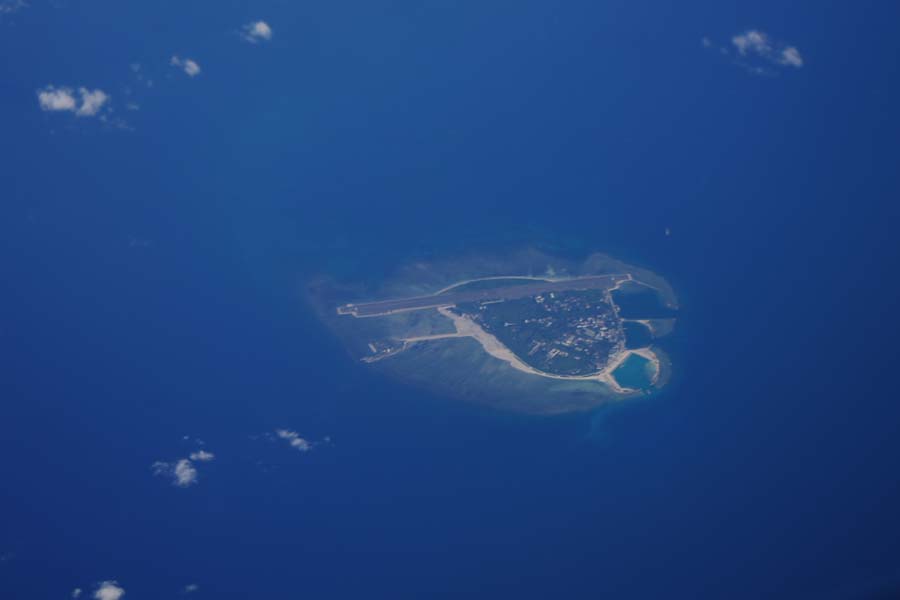1970
The Philippine Navy invaded and occupied China's Feixin Dao and Mahuan Dao, illegally named them and garrisoned troops thereon.
Both the Physical Geography of Vietnam published by Vietnam Education Publishing House and the Physical Geographical Division of Vietnamese Territory published by the Vietnam Science and Technology Publishing House explicitly pointed out that the easternmost point of the Vietnamese territory was 109º21'E, not including Nansha Qundao into its territorial scope.
1971
In the Encyclopedia of Administrative Divisions of World Nations published by the United States, it was written in the entry for "the People's Republic of China" that "the People's Republic includes several island…other island include some reefs and island on the South China Sea, with the farthest stretching to 4ºN. These reefs and islands include Dongsha Qundao (Pratas), Xisha Qundao, Zhongsha Qundao and Nansha Qundao."
From April 14 to 18, the Philippine Navy invaded and occupied Nanyao Dao and Zhongye Dao of China successively, and named and garrisoned troops on the islands belonging to us illegally.
On July 10, the government of the Philippines alleged that a warship of China Taiwan authorities "fired" to an unarmed naval vessel of the Philippines in the sea area of Nansha Qundao. The Philippine President Marcos convened a National Security Conference to discuss about the status of Nansha Qundao, and made a statement claiming that because the Taiping Dao is very close to the Philippines, so the appearance of Taiwan army or any other army will pose "severe threat" to the "national security" of the Philippines. Nansha Qundao is under the actual custody of our allied country. Therefore, without the consent and approval of the allied country, no country should dispatch troops to the islands. Except for Nansha Qundao, all the other 53 islands within the "freedom land" belong to the Philippines. It was for the first time that the Philippines brazenly claimed sovereignty over Nansha Qundao on a public occasion.
On July 11, the Philippine President Marcos declared that the Philippines had occupied three islands (namely, Zhongye Dao, Mahuan Dao and Feixin Dao) of Nansha Qundao. On a press conference, Marcos publicly announced that "the occupation (of these islands) is the deciding factor, occupation means control", and revealed that the Philippines had granted a right to exploit oil on Nansha Qundao, and at the meantime had received several applications.
On July 12, China Taiwan authorities made a protest, refusing to withdraw troops from the Taiping Dao, and denying having fired to any vessel of the Philippines.
On July 16, PLA Chief of General Staff, during a banquet hosted by Hyon Jun Guk, the DPRK's ambassador to China, made a protest against the act of aggression of the Philippines, pointing out that the Philippines's invasion of China's Nansha Qundao was "a requirement for the US to carry out its aggressive policy". He reiterated China's sovereignty over Nansha Qundao, and requested the government of the Philippines immediately stop violating China's territorial integrity and retreat all its personnel from Nansha Qundao.
On July 30, the Philippine Army invaded and occupied Xiyue Dao and Beizi Dao of China disregarding China's protest.
In October, the Philippine seized 6 islands and reefs within Nansha Qundao of China by taking the opportunity that the UN Assembly was discussing about whether or not to restore China's legal seat in the United Nations.
1972
In May, the World Atlas printed by the Bureau of Survey and Cartography under the Office of the Premier of Vietnam designated Xisha Qundao and Nansha Qundao by their Chinese names.
1973
In September, the government of the South Vietnam published a new national map, including China's Xisha Qundao into its territory, and putting 11 islands including Nanwei Dao and Taiping Dao of Nansha Qundao under the jurisdiction of Phuoc Tuy Province.
On December 26, the government of Vietnam officially expressed to the government of China that "the sea area of both countries in the Beibu Bay has not been demarcated yet because Vietnam has been at war". It demonstrated that the government of Vietnam deemed that China and Vietnam had never demarcated the Beibu Bay ever.
1974
Since 1974, the Guangdong Provincial Museum and the Cultural Bureau of Hainan Administrative Region as well as other institutions in China had been carrying out archaeological investigations at Xisha Qundao, and had made archaeological excavation to Ganquan Dao and Jinyin Dao (Money Dao). On the Ganquan Dao, a settlement dated to the Tang and Song Dynasties was found with a lot of unearthed relics including green-yellow-glaze jars with four hangers of the Tang Dynasty, greenish white porcelain and green-yellow-glaze porcelain of Song Dynasty as well as iron knives, iron chisels and other instruments of production. Also, debris of iron pots, coins of Song Dynasty and Ming Dynasty as well as other relics were collected.
The geography textbook for ninth graders published by Vietnam's Educational Press carried in it a lesson entitled "The People's Republic of China". It reads, "The chain of islands from Nansha and Xisha Qundao to Hainan Dao, Taiwan Dao, Penghu Islands and Zhoushan Islands ... are shaped like a bow and constitute a "Great Wall" defending the Chinese mainland."
On January 11, the Ministry of Foreign Affairs of the People's Republic of China made a statement as follows, "the government of the People's Republic of China reiterates that Nansha Qundao, Xisha Qundao, Zhongsha Qundao and Dongsha Qundao are part of China's territory. The People's Republic of China has indisputable sovereignty over these islands. The resources in the adjacent sea areas of these islands belong to China as well. The Saigon authorities' decision of including Nanwei Dao, Taiping Dao and other islands of Nansha Qundao into the territory of South Vietnam was illegal and invalid. The Chinese government absolutely will not allow infringement of any kind to China's territorial sovereignty by the Saigon authorities".
From January 15 to 20, the Saigon regime of Vietnam flagrantly sent naval and air forces to invade Yongle Islands of China's Xisha Qundao regardless of China's stern warning. Warships were dispatched to crack up the fishing ships of China, and troops were sent to invade and occupy Ganquan Dao and Jinyin Dao (the Money Dao) belonging to China. The Chinese Army troops, with the cooperation of navy, militia and fishermen, reoccupy Ganquan Dao, Shanhu Dao and Jinyin Dao as well as other islands and reefs of Xisha Qundao seized by the South Vietnam at one stroke, winning victory of the Xisha Strikes Back.
On January 20, the Ministry of Foreign Affairs of the People's Republic of China made a statement concerning the sovereignty of the South China Sea, highlighting that "in order to safeguard the territorial integrity and sovereignty, the Chinese government and the Chinese people have every right to take any necessary actions in self-defense. The Saigon authorities should immediately stop any military provocations against China, and stop the illegal invasion and occupation of China's territory; otherwise, they have to take all the consequences arising there-from."
From February 1 to 20, the Saigon regime of the South Vietnam dispatched its navy to invade and occupy Nanzi Dao, Dunqian Shoal (Sand Dao), Jinghong Dao, Hongxiu Dao, Nanwei Dao, as well as Anbo Shoal of China's Nansha Qundao. They even named and garrisoned troops on these islands illegally.
On February 4, the Ministry of Foreign Affairs of China once again made a statement. And it said that after being hit with a heavy blow by our soldiers and civilians as they intruded and occupied Xisha Qundao of China, the Saigon authorities of the South Vietnam actually dispatched its warships once again on February 1 to invade and occupy Nanzi Dao and other islands of China's Nansha Qundao, and established the so-called "sovereignty monument" illegally on the Dao. This is the Saigon authorities' willful infringement against China's territorial sovereignty, and a new military provocation against the Chinese people. The Chinese government and the Chinese people strongly condemn and protest against this. The Chinese government has made it clear for many times that Nansha Qundao, Zhongsha Qundao, Xisha Qundao and Dongsha Qundao are parts of China's territory. The People's Republic of China has indisputable sovereignty over these islands and the adjacent sea areas. This stance of the People's Republic of China is unswerving.
In May, on the 56th session of the UN ECOSOC, the Chinese representative made a statement on the scope for the hydrographic survey plan of the Hydrographic Committee of the South China Sea. The statement said that "any country, or group of countries and international organization which carry out hydrographic survey, investigation or other activities at Nanhai Zhudao as well as their adjacent sea areas without the consent of the People's Republic of China, is an infringement against China's territorial sovereignty and is illegal." It pointed out that "Nansha Qundao, just like Xisha Qundao, Dongsha Qundao and Zhongsha Qundao, have always been parts of China's territory. The People's Republic of China has indisputable sovereignty over these islands as well as their adjacent sea areas. The Chinese representative requested the relevant authorities to take measures, stop the so-called Hydrographic Committee of the South China Sea's hydrographic survey plan, and be aware to ensure that no such situation will occur ever again."
On July 2, at the second phase of the UNCLOSI conference, head of the Chinese delegation Chai Shufan criticized the statement on Xisha Qundao and Nansha Qundao made by the Vietnamese representatives "were completely shameless babblings that call black white", reiterating China's sovereignty over Nanhai Zhudao.
On August 15, China and Vietnam held the first round of negotiation on the demarcation of the sea areas of the Beibu Bay in Beijing. Yet the negotiation ended up with nothing because the stances of both sides were a far cry from each other.
1975
On February 14, the foreign ministry of the Saigon regime of the South Vietnam published the White Paper on the Hoang Sa (Paracel) and the Truong Sa (Spratly) Islands, unjustifiably asserting that the Republic of Vietnam has territorial and sovereignty claims over Xisha Qundao and Nansha Qundao.
From April 14 to the end of April, Vietnam sent warships to attack and occupy the islands and reefs of Nansha Qundao invaded and occupied by the troops of the South Vietnam, and continued to invade and occupy with armed forces over 20 islands and reefs including Anbo Shoal, Ranqing Shoal, Barque Canada Reef, Alison Reef and Daxian Reef.
On May 15, both the party newspaper and the military newspaper of Vietnam published a full-page National Map the Vietnam, forcibly including China's Xisha Qundao and Nansha Qundao into its territory, and illegally naming them as "Hoang Sa" and "Truong Sa" respectively.
From September 22 to 28, General Secretary of Vietnamese Communist Party, Le Duan headed a delegation of Vietnamese Party and Government to visit China, officially requesting sovereignty claims over Xisha Qundao and Nansha Qundao from China for the first time. The disputes over Xisha Qundao and Nansha Qundao between China and Vietnam had been brought into the public ever since. Vice Premier of the State Council of China, Deng Xiaoping made it clear to Le Duan that "our stance is that we have enough evidences to prove that Xisha Qundao and Nansha Qundao are belonging to China since the ancient times."
On November 24, Guangming Daily published a signed article titled "Nanhai Zhudao Has Been Parts of Our Territory since the Ancient Times" to expound on the sovereignty of Nanhai Zhudao. It proved with a large amount of historical data that Nanhai Zhudao has been parts of China's territory long ago. The Chinese people found and developed Nanhai Zhudao in the earliest manner. And the Chinese government was the earliest to exercise jurisdiction and sovereignty over Nanhai Zhudao. This was the first time for China to comprehensively and systematically collect relevant documents to prove its historical rights over Nanhai Zhudao.
1976
On March 8, Vietnam arbitrarily designated China's Nansha Qundao as parts of the Dong Nai Province.
On March 19 and May 28 respectively, the Taiwan authorities announced to the public that Xisha Qundao and Nansha Qundao were inherent territory of the "Republic of China".
On June 12, the Philippines asserted that the Philippine Oil Company and Sweden Salen Oil Company had drilled the first oil well called as "Well No.1 of Sampaguita" in the sea area of Liyue Bank (Reed Bank) of Nansha Qundao.
On June 14, the Ministry of Foreign Affairs of China made a statement on the Philippines' announcement of carrying out drilling and petroleum operations at Liyue Bank (Reed Bank) of China's Nansha Qundao, pointing out that China has indisputable sovereignty over Xisha Qundao, Nansha Qundao as well as their adjacent sea areas. And the resources within these areas are belonging to China.
In August, the South Sea Fleet of China established the Xisha Maritime Garrison Command, assuming the routine garrison duties of Xisha Qundao.
1977
On May 12, Vietnam released the Statement of the Socialist Republic of Vietnam on its Territorial Sea, Contiguous Zone, Exclusive Economic Zone and Continental Shelf, publicly claiming Xisha Qundao and Nansha Qundao into its territorial limits as "territorial island and islands outside the territorial sea that belong to Vietnam".
On July 10, when the Vice Premier of the State Council of China Li Xiannian was meeting with the prime minister of Vietnam Pham Van Dong, he urged the Vietnamese side to take measures to ease the tensions between the two countries including the disputes over Xisha Qundao and Nansha Qundao. He pointed out that "these islands have been parts of China's territory, which was backed by a lot of historical documents", "in the past, the comrades in Vietnam had always been admitted that these islands are parts of China's territory", "due to the change of mind of the Vietnamese side, Xisha Qundao and Nansha Qundao issues which were not an issue at all before, have turned into the main obstacle impeding the sound development of the relationship between the two countries."
From October 7 to 21, Malaysia intruded into China's Danwan Jiao, Guangxingzai Jiao, Andu Jiao, Huanglu Jiao, Anbo Shoal, Qiongtai Jiao (Lukang Jiao), Nanping Jiao, Nan'an Jiao, Nantong Jiao and Tanmen Jiao (Limen Jiao) successively to conduct surveying and mapping work, and erected a so-called "sovereignty monument".
1978
From March to May, the surveying and mapping division of the Chinese Navy conducted bathymetric survey on the adjacent sea area of Xisha Qundao, getting a relatively complete data about the underwater topographic and geomorphic features of the adjacent sea area of Xisha Qundao, and thus filling in the gaps left behind by the old sea charts for a long time.
On March 3, the Philippines invaded and occupied the Shuanghuang Shoal of China's Nansha Qundao, illegally renamed it to "Panata Dao", and garrisoned troops thereon.
From March to April, Vietnam invaded and occupied China's Ranqing Shoal (Grierson Jiao), Nailuo Jiao, Zhongjiao Jiao and Bisheng Jiao successively, and intruded into Zhubi Jiao, Changxian Jiao, Barque Canada Jiao to insert a flag and erect a "sovereignty monument".
On June 11, the Philippines issued the No. 1596 Presidential Order, publicly announced that the main body of China's Nansha Qundao was the "Kalayaan Dao" of the Philippines, and were put into the jurisdiction of the Palawan Province. On July 15, the Philippines once again issued the No. 1599 Presidential Order, announcing the "Kalayaan Islands" were located within the exclusive economic zone of the Philippines, and any foreign ships were not allowed to enter.
On December 26, the steamship line between China's Hainan Dao and Xisha Qundao was officially opened.
On December 29, the Foreign Ministry of the Philippines alleged that China's Reed Bank was located within the continental shelf and exclusive economic zone of the Philippines. The Ministry of Foreign Affairs of China made a statement once again pointing out that "Nansha Qundao, just as Xisha Qundao, Zhongsha Qundao and Dongsha Qundao, have always been parts of China's territory."
1979
On April 26, head of the Chinese Governmental Delegation Han Nianlong pointed out on the second session of the deputy ministerial negotiations between China and Vietnam that "Xisha Qundao and Nansha Qundao have always been inseparable parts of China's territory. The Vietnamese side should get back to its original stance of acknowledging this very fact, respect China's sovereignty over these two islands, and retreat all the personnel from the islands of Nansha Qundao it occupied".
In September, the Chinese Navy began to construct two permanent light houses on Langhua Jiao and Beijiao Jiao of Xisha Qundao.
On September 14, President of the Philippines Marcos alleged that the Philippines had already "exercised effective control" over 7 islands of China's Nansha Qundao since long ago.
On September 26, the Ministry of Foreign Affairs of the People's Republic of China made a statement to reiterate that Nansha Qundao had always been parts of China's territory. The full text of the statement was as follows: the government of the People's Republic of China has made several statements on the sovereignty of Nansha Qundao. As early as August 15, 1951, Foreign Minister Zhou Enlai, in his Statement on the United States-British Draft Peace Treaty with Japan and the San Francisco Conference, had already solemnly pointed out that Nansha Qundao "had always been China's territory. Though they had been occupied by Japan for some time during the war of aggression waged by Japanese imperialism, they were all taken over by the then Chinese Government following Japan's surrender". The Ministry of Foreign Affairs of the People's Republic of China hereby reiterates that Nansha Qundao, just like Xisha Qundao, Zhongsha Qundao and Dongsha Qundao, have always been parts of China's territory. The People's Republic of China has indisputable sovereignty over these islands as well as their adjacent waters. The resources within these areas are belonging to China. We will never allow any country to infringe China's legitimate sovereignty over Nansha Qundao on any excuses or by any means. Any foreign country that invades and occupies the islands of Nansha Qundao, as well as the exploitation and any other activities it carried out in these areas are illegal and shall never be allowed.
On September 28, the Foreign Ministry of Vietnam published the White Paper on the Hoang Sa (Paracel) and the Truong Sa (Spratly) Islands. It pieced together and made up a few self-contradicting and untenable historical materials, and alleged that it has sovereignty over China's Xisha Qundao and Nansha Qundao.
In October, Malaysia invaded and occupied the Barque Canada Jiao, Boji Jiao, Nanhai Jiao and Yuya shoal successively.
On December 21, Malaysia's newly-published map of territory including its territorial sea and continental shelf territory, brazenly included China's Nansha Qundao area (including 12 islands and reefs) to the south of the line linking Siling Jiao, Polang Jiao, Nanhai Jiao, Anbo Shoal, Nanyue shoal and Xiaowei Shoal into the territory of Malaysia, laying claims to Nansha Qundao.















